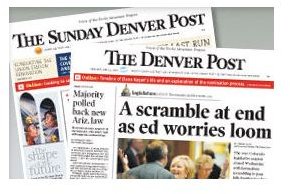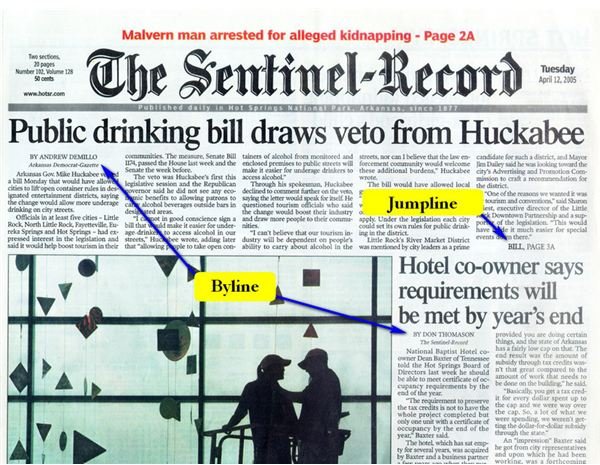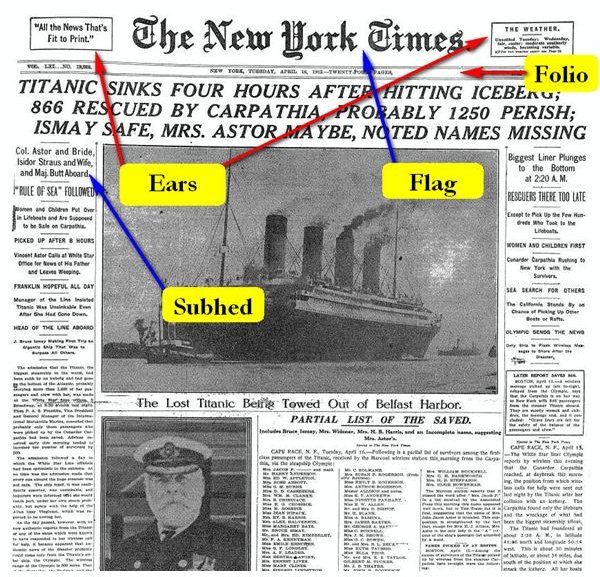Newspaper Page Elements: Definitions & Glossary of Terms
Newspaper Page Elements Definitions Glossary
There are many elements to a newspaper page, and not every element exists on every page. However, many common elements persist across various newspaper pages. Some of these terms are also used in designing newsletters. Other elements occur only on specific pages, most notably, those newspaper elements that appear only on the front page of the newspaper.
On the front page of a newspaper, the topmost element is generally where a reader will find the name of the newspaper. This newspaper element is defined as the flag or sometimes the nameplate. Some people also refer to the flag or nameplate as the masthead, although that is technically incorrect. The confusion exists because not every publication has a masthead, and in some publications, the role of the masthead and the flag are fulfilled by the same element.
It occurs only on the front page of the newspaper, and is typically an important part of newspaper branding. The distinctive font on the cover of the New York Times, for example, is immediately recognizable before one even reads the words, “New York Times” on the front page.
Some newspapers switch up the look of the flag for special editions, early editions, or Sunday editions. The Denver Post is one example of a newspaper that tweaks its flag for different editions.
The space in the upper right or left corner of the front page of a newspaper is called the ear. The ear is used for a slogan, the date, the weather, or for drawing attention to a special feature.

Beneath the flag or nameplate is a newspaper element called the folio. The folio lists the newspaper’s name, the date of the paper, the volume or edition of the paper, and often the suggested price of the newspaper. The folio is printed in a small font between the flag and the main headline as a way to display necessary information without distracting from either the branding of the paper or the lead story.
The best known newspaper element is the headline. The headline is printed in large-type and is the title or summary of the main news story for that day. Since the headline is printed in such large fonts, it is typically very short and, thus, incomplete. A subhed or subhead (depending on where you went to Journalism school) is an additional summary printed beneath the headline in smaller, but still large font as a way of both clarifying the headline and as a way of leading the reader into the story.
Beneath the subhead (if there is one) is usually the byline that lists the name of the writer or organization that prepared the story.

Newspapers seldom print every page with a single story. Several newspaper elements are used to help the reader follow complete stories and separate one story from another.
A jumpline is used to continue a story on another page. Text indicates to the reader both which page to turn to as well as how the story will be marked on that page. A story about world-wide freelance writing champion Brian Nelson, might have a jumpline saying, “See Nelson, Page A4,” for example.
To help break up elements of a newspaper page a straight line is printed between stories or advertisements. This line is called a rule.
A few other newspaper terms can be helpful for communicating where to place elements on a newspaper page. The most common of these newspaper terms is fold. Fold used to literally mean the line caused by where a printed newspaper was folded over. These days, fold is generally used to refer to the top half of the page in the case of broadsheet newspapers (those that are not folded and open like a book), or the part of the newspaper page that appears without scrolling on for articles or pages printed online.
Knowing some basic terminology can help publishers communicate effectively about newspaper page elements. These terms should be the start of your newspaper elements glossary. If you ever need to make the leap from creating your own newspaper using free desktop publishing software to having your newspaper printed by a commercial printer, you’ll be ready.
